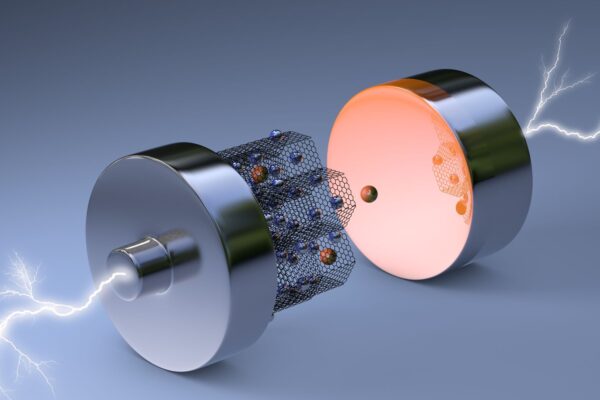長い間無視されてきた双極子-双極子相互作用が生命を形づくる Long ignored, dipole-dipole interactions give life its shape
2022-09-26 マサチューセッツ大学アマースト校

Attraction between the dipoles of several macromolecules leads to their mesomorphic assemblies, in contrast with typical polyelectrolyte behavior. Credit: Shibananda Das
双極子は、高分子電解質をより双性イオンらしく振る舞い、『反高分子電解質効果』を発揮させることができる。この効果は、双極子が化学結合でできている従来の化学的ポリ双性イオンの特徴でもある。したがって、希薄溶液中の物理的ポリ双性イオンでは、鎖内双極子相互作用によりグロビュールからコイルへの転移を示し、イオン強度の増加とともにポリマーサイズが大きくなる。”
これらの双極子で構成される高分子は、”中間型 “と呼ばれる状態を示す。中形態では、高分子は広く分散しているわけでも、きつく巻きついているわけでもなく、安定で均一な大きな構造体に集まっており、「自己毒」すなわち溶解する能力を持っているのである。
<関連情報>
- https://www.umass.edu/news/article/game-changing-new-theory-upends-what-we-know-about-how-charged-macromolecules-self
- https://www.pnas.org/doi/full/10.1073/pnas.2204163119
高分子電解質溶液における双極子駆動型メゾモルフィズムの幕間 Dipole-driven interlude of mesomorphism in polyelectrolyte solutions
Di Jia and Murugappan Muthukumar
Proceedings of the National Academy of Sciences Published:September 26, 2022
DOI:https://doi.org/10.1073/pnas.2204163119
Significance
Control of self-assembled structures of charged macromolecules in aqueous solutions is vital in myriads of natural phenomena. In the simplest situation, uniformly charged polyelectrolyte chains in electrolyte solutions are homogeneously distributed due to their electrostatic repulsion. In stark contrast to this well-established result, we find that the same system exhibits rich phase behavior consisting of precipitation, an interlude of self-assembled mesomorphic structures that can self-poison, and homogeneous solution, in the presence of a small organic anion. Using conceptual arguments, our experiments reveal that this phenomenon originates from dipole–dipole interactions overwhelming charge–charge repulsion. The discovered principle of dipole-directed assembly is essential to understand and control macromolecular structures in the broader context of polyzwitterions, polyelectrolyte–surfactant complexation, coacervation, and membraneless organelles.
Abstract
Uniformly charged polyelectrolyte molecules disperse uniformly in aqueous electrolyte solutions, due to electrostatic repulsion between them. In stark contrast to this well-established result of homogeneous polyelectrolyte solutions, we report a phenomenon where an aqueous solution of positively charged poly(L-lysine) (PLL) exhibits precipitation of similarly charged macromolecules at low ionic strength and a homogeneous solution at very high ionic strength, with a stable mesomorphic state of spherical aggregates as an interlude between these two limits. The precipitation at lower ionic strengths that is orthogonal to the standard polyelectrolyte behavior and the emergence of the mesomorphic state are triggered by the presence of a monovalent small organic anion, acrylate, in the electrolyte solution. Using light scattering, we find that the hydrodynamic radius Rh of isolated PLL chains shrinks upon a decrease in electrolyte (NaBr) concentration, exhibiting the “anti-polyelectrolyte effect.” In addition, Rh of the aggregates in the mesomorphic state depends on PLL concentration cp according to the scaling law, Rh~c1/6p. Furthermore, at higher PLL concentration, the mesomorphic aggregates disassemble by a self-poisoning mechanism. We conjecture that all these findings can be attributed to both intra- and interchain dipolar interactions arising from the transformation of polycationic PLL into a physical polyzwitterionic PLL at higher concentrations of acrylate. The reported phenomenon of PLL exhibiting dipole-directed assembly of mesomorphic states and the anti-polyelectrolyte effect are of vital importance toward understanding more complex situations such as coacervation and formation of biomolecular condensates.



